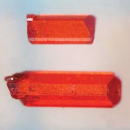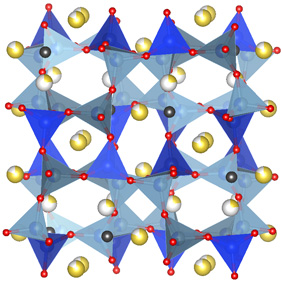| |
Our goal |
The goal of the Earth sciences is to understand how nature works, and to
contribute to achieving a safe and stainable development society. The society
takes an increasing interest in global issues which threaten to destroy
communities and environments, such as earthquake, tsunami, volcanic eruption,
and localized heavy rainfall. The Earth is made up of water and rocks.
A rock is an aggregate of minerals. Therefore, geoscientists regard a mineral
as the minimal component in the Earth. Mineralogy is the study of minerals.
Understanding how minerals work is linked to understanding how the Earth
works. The knowledge of the properties of minerals can help us to find
the best solution for the global issues. We will contribute our efforts
for the promotion of not only the Earth sciences, but also physics, chemistry,
biology, and technology. |
 |
|
| |
|
|
|
|
| |
Mineralogy of the Earth's interior |
Since ancient times, people have wanted to get to know what the interior
of the Earth looks like. Even with the most advanced technology in the
world, we haven't directly collected mineral and rock samples from the
deep Earth yet. However, we can create the deep Earth's interior in an
enclosed space of the diamond anvil cell (DAC) in our laboratory, because
the DAC technique can generate high-pressure and high-temperature conditions
of the Earth and planetary interiors. We are investigating the mineral
properties and behaviors under the mantle conditions by the DAC technique. |
 |
|
| |
|
|
|
|
| |
Physics and chemistry of minerals |
Minerals constitute the major part of the solids of the Earth. The
minerals are also included as a nanoparticle in the atmosphere, liver water,
lake water, groundwater, and ocean. Their distributions, properties, and
functions on the Earth's surface still remain unknown. Studying a mineral
is to know what properties the mineral has, how the mineral behaves, and
how the mineral interacts with many Earth's surface processes, which is
the most important contribution to the Earth and planetary sciences. We
are studying minerals to clarify their physical and chemical properties,
and to understand their behaviors and interaction with Earth' natural systems. |
 |
|
| |
|
|
|
|
| |
Crystallography |
A mineral is naturally crystallized as a crystal. Properties of crystals
are definitely determined by their atomic arrangements. Their crystal morphologies,
optical features, and many physical properties, such as equation of state,
thermal expansion, and melting point are attributed to the crystallographic
symmetry which has a repetitive pattern of the crystal lattice in space.
All of the crystal properties are, therefore, explained by the highly ordered
atomic arrangement. That is, investigating crystal symmetry helps us to
understand the crystal properties. We are studying the crystal properties
through the approach of crystal growth techniques, diffraction observation,
and crystal structural analysis methods. |
 |
|
| |
|
|
|
|
| |
Solid-state physics |
Studying minerals is to investigate a solid state material itself. The solid state materials include all of solids and cover a very wide range of materials sciences which focus on crystalline matter, amorphous, metal, semiconductor, insulator, organic matter, inorganic matter, organic-inorganic composite, and nanomaterial. Solid materials possess various macroscopic properties, such as electronic, magnetic, thermal, optical, and mechanical properties. The solid-state physics is therefore to explain how the macroscopic properties of the materials result from their atomic scale interactions. We are conducting researches on the macroscopic properties of solid materials by advanced experimental techniques and efficient simulation methods. |
 |
|
| |
|
|
|
|
| |
Descriptive mineralogy |
Natural history is the observation and description of the natural world.
The study is composed of natural sciences dealing with animals, plants,
and minerals. In A.D. 77, Pliny the Elder who published an encyclopedia
"Natural History" already described many different minerals and
explained many of their properties. Descriptive mineralogy is a study to
observe and describe the minerals found in rocks in terms of their color,
morphology, luster, hardness, chemical composition, and crystal structure.
New minerals which nobody has found can be recently discovered by advanced
measurement techniques. We are carrying out the observation and description
of minerals occurring at various localities. |
 |
|
| |
 |
| Copyright © 2004-2025 Atsushi Kyono. All Rights Reserved. |

